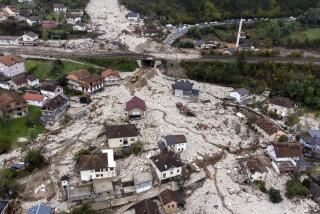Jets, Tanks Attack Key Croatian Town : Yugoslavia: The European Community presses for a new cease-fire but Serbia continues to hold out.
BELGRADE, Yugoslavia — Air force jets, army tanks and heavy artillery attacked the strategic Danube River town of Vukovar in eastern Croatia late Friday in an onslaught that could give Serbian rebels a key foothold in the republic.
The European Community worked desperately for a new cease-fire but seemed unlikely to achieve it before a deadline set by Croatia, which says it will mobilize all able-bodied males for war if the federal army does not withdraw to barracks by today.
The attacks on Vukovar, on Croatia’s eastern border with Serbia, started about 7 p.m., intensifying during the evening, a Croatian Defense Ministry spokesman said.
Sniper and mortar fire was heard during most of the afternoon in Vukovar. A brief lull allowed reporters to leave the town before the evening attack.
The loss of Vukovar, 150 miles east of Zagreb, would be a blow for Croatia and would give Serbian rebels a bridgehead to attack Osijek, Croatia’s fourth-biggest city and the provincial capital of Slavonia, the eastern Croatia province where much of the fighting is taking place.
Osijek, 24 miles northwest of Vukovar, came under attack about midnight Friday with machine-gun fire and mortars.
Vukovar, once inhabited by 80,000 people, has been the focus of a week of bitter fighting between Croats and the republic’s Serbian minority. Local hospital officials said earlier Friday that 16 people had been killed.
The Defense Ministry spokesman, who under Croatian regulations cannot be identified, reported heavy shelling of Kostajnica, another strategic town 50 miles southeast of Zagreb. More than 250 mortar shells fell on the town Friday afternoon, he said.
The European Community has proposed a peace conference for Yugoslavia if a truce takes effect by Sunday. If not, the 12 EC foreign ministers agreed to take unspecified measures against Serbia, seen as the link between rebel Serbs in Croatia and the federal army.
Conscripts to the army come from all republics, but its officer corps is predominantly Serbian, especially since several republics have begun refusing to allow army recruiting.
Croatia, which declared independence June 25 in tandem with Slovenia, has endorsed the EC peace plan. That left Serbia, largest and most powerful of the six republics, the last key player still undecided on the proposal.
Serbia will take “an official stand” on the EC plan today, said a source close to Serbia’s government and its president, Slobodan Milosevic.
At least 280 people have died in the fighting that broke out in Croatia after it declared independence.
The army says it is trying to keep warring sides apart to prevent full-scale civil war, but increasingly it seems to be siding with the Serbian rebels.
EC envoy Henry Wijnaendts on Thursday supported Croatian complaints that the army is helping Serbian guerrillas in Croatia hold territory captured from the republic’s outgunned security forces.
The U.S. State Department on Thursday also charged that Serbia bears a “particular and growing responsibility” for the spiraling violence in Yugoslavia.
The well-equipped army is nominally under the command of the eight-member collective federal presidency, where Serbia and its allies control four votes. But some military units have appeared to act independently.
Ethnic Serbs, who make up 12% of Croatia’s 4.75 million people, say they want to remain part of Yugoslavia. Croatian officials say the insurgents hold about a quarter of Croatia’s territory.
At Oriovac, near the border with Bosnia-Herzegovina, federal soldiers being withdrawn from Slovenia forced their train to stop and surrendered themselves and their weapons to Croatian authorities, Croatia’s Information Ministry said. Other Croatian sources confirmed the report.
The federal army agreed to pull out of Slovenia after bloody skirmishes with Slovene territorial forces, but refused to leave Croatia, which is Slovenia’s neighbor.
More to Read
Sign up for Essential California
The most important California stories and recommendations in your inbox every morning.
You may occasionally receive promotional content from the Los Angeles Times.










